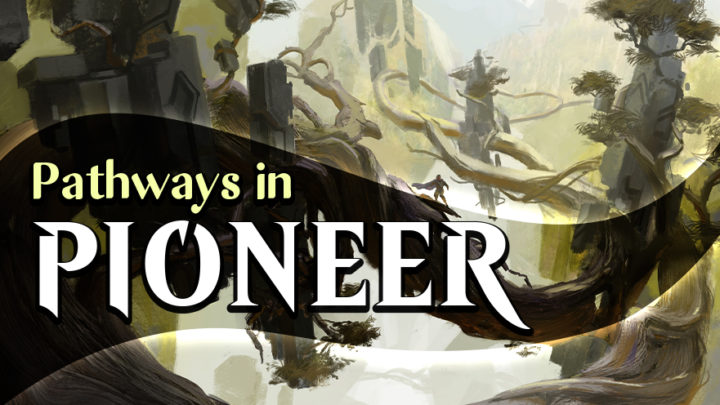Pioneer has always had issues with ally-colored lands. It’s the reason why decks like Mono-Black Aggro or Mono-Red Aggro refrained from splashing black and U/W control hasn’t added red. Numerous times, we’ve been waiting for a Masters-style set to come out that would mitigate this problem, and multiple sets coming through Standard were under the microscope as well. Would we get allied fast lands back? Maybe allied pain lands? At this point, we would have taken anything.
Well, we did get something — Zendikar Rising’s Pathways.
Pathways come in six two-color combinations. They’re nonbasic lands that enter the battlefield untapped, and you get to choose which side you want to play. That’s it!
What makes for a very simple, yet elegant design, also makes for some serious deck-building decisions in Pioneer. Are these lands enough to push ally-colored decks into prominence?
Well…it’s complicated…
Why Play Pathways?
It’s important to understand what makes these lands good in some situations and not so good in others. They don’t have basic land types, so you cannot get them with, say, Fabled Passage. Plus, once you’ve played your Pathway, you can’t flip it over to access the mana on the other side — if you play it as a land that makes red mana, that’s what it’ll do.
The immediate thought here is this: The faster and/or lower to the ground your deck is, or the more mana symbols your mono-colored cards have in their mana costs (GG or RRR, for example), the less effective these lands will be. They do no more than what a basic land would do, so you suffer the same penalty as you would with a basic in play. Furthermore, you don’t get to play nicely with buddy lands, or any land that cares about basic land types. If you need that sort of thing, then you’re better off just running basics.
Which begs the question: Where do you put these?

Any big-creature aggressive deck is a good start. Think Monsters decks that aren’t too strapped for specific colors of mana early on. Slower control decks are also a nice fit, especially if you aren’t planning on casting multicolored spells like Azorius Charm or Drown in the Loch on turn two. Effectively, this cuts out mana dorks and quirky guild cards.
Things get a bit murkier when you add a third color into the mix, especially if that third color already has a Triome supporting it. If you’re playing something like Esper, a couple of these could work, as you’ll often be working to get your second allied color when you have a basic-heavy draw. They won’t replace your Fabled Passage draws, but they’ll help supplement them a bit, as long as you’re willing to play more lands overall (which you should be doing nowadays, anyway, due to the relatively slow speed of the format).
Where I think these Pathways shine is in decks like Mono-Black Aggro or Mono-Black Vampires, should you choose to splash a color. These decks are low to the ground already, but are light on the splash color demand. When your Vampires deck is splashing white for Blood Baron of Vizkopa, you don’t have to worry about which side of the Pathway to play until you actually need it. Same goes for something like R/W Burn, where your only gold card is Boros Charm, and you don’t have to cast it on turn two. Rakdos Pyromancer is another deck that has been emerging for the past couple of weeks, and it’ll only get more consistent as these lands enter the format.
If you’re looking for a starting place, here’s a potential new deck:
Jund Sacrifice
4 Cauldron Familiar
4 Gilded Goose
2 Kroxa, Titan of Death’s Hunger
4 Mayhem Devil
4 Priest of Forgotten Gods
4 Satyr Wayfinder
3 Woe Strider
1 Bolas’s Citadel
4 Thoughtseize
4 Trail of Crumbs
4 Witch’s Oven
4 Blood Crypt
4 Blooming Marsh
2 Forest
4 Llanowar Wastes
4 Overgrown Tomb
4 Stomping Ground
1 Swamp
Decks like these don’t do too much with basics, nor do they care very much about hitting both of their one-drops as early as possible. Both of these are good qualifiers to play Pathways instead of those basics, especially in large quantities. There is a small risk of getting hit by Field of Ruin, but honestly, the curve on this deck is so low, and the pacing so slow, that it likely won’t be too much of an issue.
Pathways are a welcome addition to Pioneer for a lot of ally-colored decks. While they won’t solve these decks’ mana problems overnight, they’ll definitely alleviate some issues that have plagued Pioneer since its inception. I expect many a deck to prop up because of these lands alone, and if there are any playable ally-colored cards in Zendikar Rising, I would definitely expect Pioneer players to go full experimental mode in an attempt to break them.

Anthony Lowry is a high level competitor in several games, and Magic is no exception. His newfound passion for deckbuilding has reignited his drive to compete and test his skill against the best.

